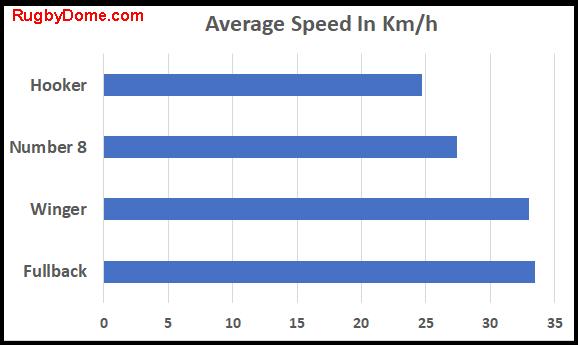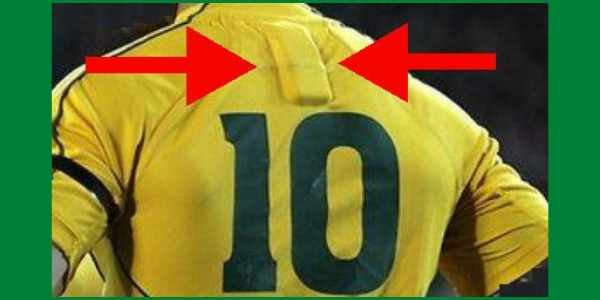It’s no surprise that statistics show that wingers and fullbacks are the fastest players on a rugby pitch. But how fast do they actually run?
And are they naturally fast, or can rugby players train to increase their speed? This article takes a close look at these questions.
How Fast Do Rugby Players Run?
When we look at how fast rugby players run, we should distinguish between the maximum speed that they reach in a sprint versus the average speed through a sprint.
Maximum speeds
One equipment company did a study during the Rugby World Cup of 2019 to measure the maximum speeds achieved in matches.
This bar chart shows averages by position:

Here are the raw numbers:
| Position | Km/h |
| Fullback | 33.48 |
| Winger | 33.00 |
| Number 8 | 27.43 |
| Hooker | 24.66 |
For reference, legendary Olympic sprinter Usain Bolt recorded a maximum speed of 44.72 km/h in the fastest stretch of his record-setting sprints.
The numbers I’ve mentioned above are averages for rugby players. But what about the speediest players?
Winger Jonny May of England reached 37.71 km/h on the pitch. His Irish counterpart, Jacob Stockdale, hit an impressive 35.80 km/h.
These two wingers achieved these in matches in the biggest rugby competition in the world. If we drop down a few levels, we can see even higher times of speed merchants.
Aaron Sexton is an international sevens player for Ireland, but he also plays fifteens rugby for the Ulster province. He clocked a maximum speed of 37.8 km/h in an A (second fifteen) game against Connacht. That slightly edges Jonny May.
Average speeds
What about average speeds that are maintained through a sprint? South African winger Cheslin Kolbe has an average of 33.66 km/h
This is actually faster than the general maximum speed averaged across all wingers or fullbacks in the World Cup tournament.
How are these speeds measured?
You may be wondering how these speeds are measured while a match is taking place.
Ever noticed a little square bump on the back of elite players’ jerseys?

That houses the equipment that measures speed as well as a lot of other things. Check out our article on GPS trackers in rugby to learn more.
Why Do Rugby Players Need To Be Fast?
There is an old adage in sport: speed kills. This is as true in rugby as it is in any game.
No matter what a player’s skill level, if he can’t get to the play as fast or faster than his opponent, he’s going to lose. Speed allows a player to:
- get to the ball first
- make a tackle
- avoid a tackle
If a team is dominant in the speed department, they are very likely to be dominant in the match.
Scoring tries through speed
Many scoring outcomes boil down to one player with the ball sprinting as fast as he can to score, while the opposing players sprint as fast as they can to catch him.
Speed, and nothing but speed, determine the outcome of this play.
This is why rugby players and teams at every level are concerned with training for speed.
Can you train for speed?

Some people believe that you can’t coach speed, but this is simply not the case.
While a player’s speed potential may be set by their genetics, this potential is a wide range. It’s probably true that few people reach the full potential that their genetics allow.
Proper speed training allows the player to get closer to maximizing their potential. The elite rugby clubs have come up with several effective methods to train their players to be faster on the pitch.
Some of these methods are what you would expect: weight lifting to build stronger legs and sprint training. But speed training is not limited to just this.
Let’s take a look at some specialist training in rugby that you may not have heard of. But your favorite elite players are probably being put through their paces with these techniques!
What Is The Beep Test In Rugby?
The beep test, also known as the bleep test or the pacer test, is a very common fitness test and training tool used in many sports, including rugby.
It is essentially a form of shuttle run. Cones are set twenty meters apart. The players then run back and forth between these cones. This is a shuttle run.
But the beep test has a vital difference. Players wear a beeper and must keep pace with the beeping tones. As each minute passes, the tone speeds up.
The players keep going until they can’t keep up the pace or have to stop completely.
Why the beep test is feared
Does this sound not so bad? Well, the first few minutes are at a jog. But as the test proceeds, the pace picks up to a real sprint.
This has several effects. The beep test
- floods the player with lactic acid
- depletes their oxygen
- tests their ability to keep functioning at a high level with max effort.
These drills are often run as a team, with players competing to see who can go the longest.
The beep test is considered a test of cardiovascular fitness and is feared for its incredibly grueling nature. However, it also has a real connection to speed on the pitch.
It’s used both as a test of conditioning and a way to train for conditioning.
Why is the beep test used in rugby?
This gives the beep test several applications for in-match speed. While it’s not strict speed training, like a pure sprint workout, it does train speed in a match-like condition.
This is because pure sprint training allows long rests between sprints. This isn’t the way the action plays out on the rugby pitch. The rugby player needs to be able to generate speed as needed and this is often without any significant rest between maximum speed efforts.
The beep test trains the player to be able to handle lactic acid.
It also trains the player to be able to think, function, and-most importantly-accelerate while in a state of cardiovascular fatigue.
Because of this, beep test training maximizes the player’s ability to generate speed in a match situation.
Has the beep test gone out of fashion in rugby clubs?
The beep test used to be all the rage some years ago. Elite players are naturally very competitive and would post their scores on social media. Other players would try to beat people, especially in their own position.
However, the beep test is increasing being recently replaced by another type of shuttle run.
What Is The Bronco Test In Rugby?
The bronco test, like the beep test, is a form of shuttle run.
It originated in New Zealand and was popularized by the All Blacks. With their fearsome reputation, there’s no surprise that the bronco test has now become the most popular fitness test at the elite rugby levels.

Bronco test training does pretty much the same things that the beep test does. But the general feeling among rugby clubs is that it does them better.
Unlike the beep test, the bronco test is run for individual times. So, it doesn’t lend itself to running as a competitive group drill as well as the beep test does.
A breakdown of the bronco test
For the bronco test, cones are set up at zero meters, twenty meters, forty meters, and sixty meters.
When the player is told to start they run from zero to sixty meters, then zero to forty meters, and zero to twenty meters. This is all without stopping.
This is considered one rep.
The test consists of five reps, performed as quickly as possible with no break in between. The player’s time to complete the entire five reps is their score.
The bronco test is commonly run at the beginning and end of the pre-season to gauge improvement.
What Is Plyometric Training In Rugby?

Plyometrics is a training method that originated in the Soviet Union back in the day.
It is designed to increase explosive power by training the muscle to go from a stressed, stretched position into an explosive contraction as quickly as possible.
It is often called jump training because all of the most common plyometric exercises involve jumping.
The idea of this kind of training is to learn to direct the energy from the stress of the landing into the explosive contraction that happens right afterward.
This is a method that should only be tried under the supervision of a competent professional trainer.
That’s because it’s a maximum power ballistic workout and has a real potential for injury if done with poor form.
Plyometrics for rugby players
Plyometrics are a regular part of the training for elite rugby players for obvious reasons. Since they enhance the explosiveness of the muscles, they also enhance both running speed and power.
Virtually every common plyometric exercise is some variation of a jump, so they are particularly good for legs, and therefore running speed.
These exercises include many types of jumps including:
- depth jumps
- box jumps
- single leg bounding
- power skipping
At the elite rugby levels, these are trained no more than twice a week, for very short sessions.
Because the emphasis is on maximum explosive speed, there is generally a long period of rest between repetitions.
Related Articles
Of course, players can’t keep their top speed for an entire match. But they don’t need to. Often they are stationary as play unfolds on another part of the pitch. If you want to know more, check out our article on how far rugby players run in a match.
How does these speeds compare to other sports? Check out our article that compares whether American football players run faster than rugby players.